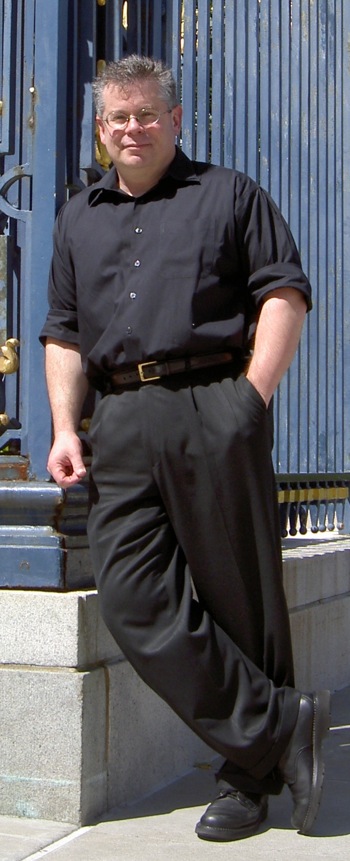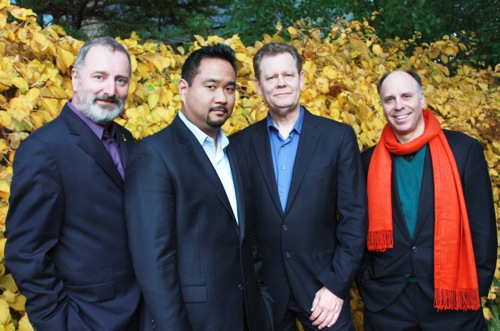Mozart in Vienna – the good times
Musicologist Robert Greenberg pooled resources with the excellent Alexander String Quartet at St. John’s Presbyterian Church in Berkeley last Saturday morning to recreate the heady music scene of eighteenth century Vienna.

Sponsored by San Francisco Performances, this very popular combination of lecture with live demonstrations and a concert has been luring Saturday morning crowds in Berkeley for a decade. This was the second in a three-part series on Mozart after he escaped provincial Germany and the cold demands of his father, Leopold, to come to Vienna, the cultural capital of the German-speaking world.
“And he went wild!” claimed Greenberg, as he described Mozart’s newfound freedom and extravagant lifestyle.
On a weekend morning, that lecture could have been difficult for anyone not a musicologist, except that the drama and provocative claims of Greenberg, who regularly “goes wild” in his presentations, supplied a gripping narrative to the music. In combination with the lush sounds of the quartet, it was mesmerizing.
Their subject was the Haydn Quartets, six early quartets that Mozart wrote and dedicated to the much older composer. An unlikely friendship grew between the 26-year-old enfant terrible and the equable 50-year-old Joseph Haydn, as the newcomer played viola along with the inventor of the quartet, mastering this new form as he tried out his own thoughts.
Greenberg described Haydn’s creation of the quartet form – and Mozart’s appreciation of it – as a product of its time: four different voices that come together to create harmonies but also respond to each other’s statements in lively discourse. “Mozart’s Opus 33 quartets were the Voice of Independence, a metaphor for individual freedom combined with social responsibility, as Rousseau put it [in his Social Contract].”
The third quartet, in E-flat, opens with all four playing in unison, using nine of the twelve semitones in a provocative statement that slurs its way into “false” resolution, followed by a sprightly, and very Haydnesque, exchange, almost glossing over the original statement. This is Mozart using Haydn’s form to stretch his own wings and then wink at the master.
“We have often heard,” Greenberg added, “that Mozart was very popular, a Barry Manilow of his time… or Barely Manilow, I call him. But really Mozart was a Tupac Shakur, greeted with both fanaticism and loathing.” He went on to read gripes by the critics, who called Mozart “too consistently artful,” in his profusion of ideas.
“Hah!” cried Greenberg, and went on to describe the art behind the artful, something that was too advanced for that time and has been seldom equaled since. “The modulating bridge, or ‘development,’ is fragments of the melody with unstable harmonies. But in the second movement Andante it is seamless, blending into a single melodic arc. The two themes and the development all propel together with a constant sense of growth and development.”
“The third movement is a genuine homage to Haydn, a sophisticated rusticity, if one may say that… and in the fourth he draws out the tension (with something called an extended dominant chord, if you must know) and we can taste the tension! It is teasing! And then it finally resolves like… well, like having the seat belt light go off and getting to go to the john,” and in a quieter aside, “like that woman in the front row who couldn’t wait for my lecture to end… Or like finding an April Fool’s card inside an official IRS envelope. Hah!” Amid much audience laughter he did a thorough explication, with the quartet onstage to play each example.
Later, his words came back to us while we heard themes appear and transform. Liana Bérubé of the Delphi Trio substituted for ailing second violinist Frederick Lifsitz, with all the rigor and camaraderie that is requisite for an “effortless” sound. Cellist Sandy Wilson nodded entrances to her, as his own remarkably rich sound propelled their lush chords. That bass line was a springboard for Zakarias Grafilo, a sure violinist with lots of edge on his bow. Paul Yarbrough bridged the octaves with the charm of viola, and their many years of practice showed in their easy tempo changes – without even looking up!
 And then the magic repeated with Mozart’s “Horn” quartet, so named because of his deceptively simple use of dominants and fifths like the call of a hunting horn. Here, the ASQ was sprightly and generous, and we could hear Mozart at his happiest. In between moments of audacity, there was a sense of kindness, a generosity of spirit that felt like a gift.
And then the magic repeated with Mozart’s “Horn” quartet, so named because of his deceptively simple use of dominants and fifths like the call of a hunting horn. Here, the ASQ was sprightly and generous, and we could hear Mozart at his happiest. In between moments of audacity, there was a sense of kindness, a generosity of spirit that felt like a gift.
Greenberg and the ASQ conclude this three part series next Saturday, Dec. 20 at 10:00 a.m. at St. John’s Presbyterian, 2727 College Ave, Berkeley. Treat yourself!
—Adam Broner
Photo top of Robert Greenberg. Below, the Alexander String Quartet, from left, Sandy Wilson, Zakarias Grafilo, Paul Yarbrough and Frederick Lifsitz, who was replaced for this concert by Liana Bérubé.
